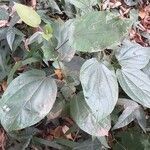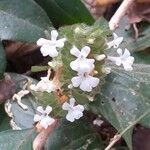Perennial herb, 0.25-0.60 m high; branches with a variable tendency to root at lower nodes, with or without woody rootstock. Leaves petiolate, broadly ovate to ovate or subelliptic, slightly to distinctly anisophyllous, acuminate to acute apex. Corolla > 8 mm long, if shorter, then plant with woody rootstock at base. Flowering time Jan.-Nov.
Dwarf shrub, up to 0.6 m high. Leaves elliptic to ovate, base unequal. Inflorescence in dense cylindrical or ovoid spikes at nodes or terminal. Anticous 2 calyx teeth linear-ligulate, acute. Flowers white or purplish.
A more or less hairy and slightly viscid herb or small undershrub 1-2 ft. high
Small white or purplish flowers in ovoid or short-cylindric spikes.



